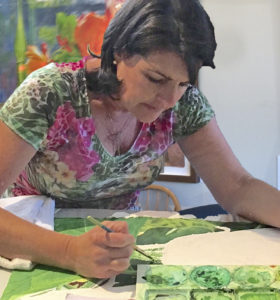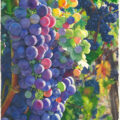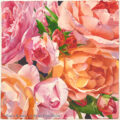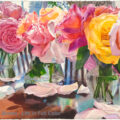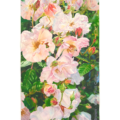My Teaching Manifesto
I share with you the process I go through to make a painting, which, for me starts with an image. I have a journalist’s brain – my paintings come from my lived experience in the world – not from somewhere inside me. I listen for the voice that says “paint this” in response to something I see. More accurately, as a feminine-oriented being, the voice seems to come from the thing – the flower, the ripe fruit in the tree, the pastry, the sweet puppy face. This is where my art begins. Then I use my camera to capture what has captured me. I teach this process.
There is a craft to be learned – or honed – that of using the paint, water, brushes, paper in particular ways to particular effects. I don’t assign paintings or exercises to practice these skills, and I don’t use special techniques or “tricks.” I’m best used to teach the way I learned, by actually painting something that I want to paint. How to handle watercolor can only come by handling watercolor. Ultimately it’s your solo journey. But I can help you – by describing and demonstrating skills as you need them for each part of your painting as you encounter it. The desire to make a painting we’re proud of is a powerful motivator. It keeps us sticking with it when it’s hard – and it is hard for almost all of us. By finishing every painting, I’ve really learned to work with watercolor. I can help you learn more easily because of the way I observe what happens. That said, ours is a wild medium and is resistant to being tamed. It’s one of the reasons it’s so beautiful.
There’s also the world of color to be appreciated and learned. If there’s any part of making art that is innate for me, it’s seeing color – I have a really good color memory and the capacity to see color in color. I am fearless in mixing colors. AND, I’ve not always been this way – I have trained my eye/brain by using and paying attention to color. You can too! I have studied paints and pigments and their properties and have extensive knowledge about the stuff that brings the color to our work.
For those of us who are called to make representational artwork, learning to see shapes and shades is how to make our paintings come alive with reality. This takes practice – it’s not a way of seeing that we are accustomed to. It’s seeing beyond the “thing” to see it as it actually is. It’s surprising to see the difference in these two ways of perceiving the world – to focus in and see the curves and lines, shadows and intersections of the petals that make up a rose, versus seeing “a rose.” It is in this way that the photograph is our servant in the process of making art. It captures the information that makes it easier and more practical to see what was there the moment we were inspired.
Learning the skills, the colors and how to see is the means to a much more important end. There is no one else who is ever going to make the art that is in you – not the way you paint when you first start out, not when you’ve been painting for many years. Every time you put your brush into a pool of paint and touch it to your paper, it’s you. It carries your mark, like the tone of your voice and the way you sign your name. Learning to paint is learning a new way to show the world who you are. And the more you do it, the more refined your expression becomes, the more vivid is the illumination of your you-ness to the watercolor paper. The consciousness of the person lives in the work they make. I used to go to art shows, appreciating the delicacy and loveliness of the watercolors longing to be able to do that. Now, with the body of work I’ve created, I see and hold myself altogether differently. I experience a level of freedom that I didn’t imagine was possible for me. I am more myself than ever. I have grown through my paintings. And since I’ve been leading groups, I’ve seen that transformation happen in others.
I am a tirelessly curious observer of the creative process, of the things we say to ourselves when we are creating. (Many of which make creating very challenging!) I create an environment that makes it safe for you to risk – all art-making is risky at some level – in the face of your own critical voices. It’s hard to see the beauty in what you’re doing with a lot of inner kibitzing. The group is the antidote to that. We are all outside your head and can see your work in a way that you may not – at least while you are working so closely to it.
I’m here to tell you, thousands of hours of painting and I still have that critical voice pick apart what I’m doing! I find that it takes me several months after the art is framed and hung to start seeing it as others do. It takes that long to forget all the parts I struggled with – like seeing my chin with a 10x mirror! I venture to say that these voices never go away. It must be part of the design. If we are growing as artists, as creators, we are going to have some inner resistance, working against which strengthens us. You may not want to frame every piece of art you make, but every effort is worthy in your evolution and is to be honored and appreciated. Even if you are an experienced painter, you still will benefit from the view from the outside, sometimes it’s hard to like what’s going on with your painting – the group and I provide that perspective!
As the person who is leading the group or teaching the class, I hold the preciousness of your process. While you are painting, learning, exploring, operating in the face of your own resistance, you are being transformed. And it’s not even necessary to talk about it in the moment – in fact it seems to be best that we don’t – it just happens! Eventually the desire in you to make art that astonishes you, fuels you to do just that. You are changed by revealing yourself in this way and you bless the rest of us with this view into you.
I invite you to join in.

